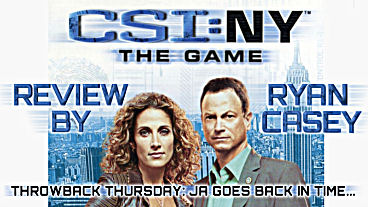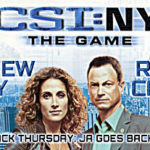
Throwback Thursday – CSI:NY The Game






Note: This review was originally published on August 2, 2009
CSI, like Law and Order, is one of the Hydras of television dramas. It has reared various heads, from the original show in Las Vegas to a spin-off in Miami to yet another derivative set in New York. As the first two shows have already been translated into PC adventures, it was only a matter of time before the crime scene investigators of New York got their own animated mysteries to solve. Unfortunately, they seemed to have missed out on the benefits of the previous games and are instead part of a watered-down version that is almost a caricature of what the series once was, but that nevertheless has its own (limited) entertainment value.
In each episode (there are four, with a fifth that will be available for download in 2009), you play one of NewYork’s finest investigators, all voiced by the actors of the television series. Naturally, they do a fine job, if not in a somewhat histrionic fashion at times, and their co-stars are also appropriate for their roles. Each game starts at a new crime scene. At each new place that you encounter, there is a row of photographs at the bottom of the screen that slowly develop to reveal a series of objects, which you must then find in the scene. This must be the hundredth hunt-and-find game I have played in the past year, and this one seems even sillier than the rest, because there is really very little point to it. First of all, there is no rhyme or reason as to why you are collecting most of these objects. Some do become evidence or puzzles, but the majority of them are not used for anything. You also have to wonder why, for example, there is a key sitting on top of an elevator, or other objects hanging out in places where nobody in their right mind would leave them. Nevertheless, there is a hint button that you can use, although once you use it, it has to charge up again before you can get another hint. Also, if you click haphazardly, your cursor will temporarily disappear for a few seconds as a scolding for your wanton detecting.
As I said, some of the items in each room become puzzles to solve. These are all mostly straightforward and simple — a lot of matching and logic puzzles. You have the option to skip two mini-games per case, although there is a built-in hint system, which gives you a hint alongside a picture of what the solution looks like, so perhaps “hint” really isn’t the best word. The other puzzles occur in the morgue and at the lab. They consist of a variety of, once again, matching and logic-based puzzles — i.e. putting together bone fragments, matching DNA samples, etc. Not surprisingly, it takes little effort to figure them out relatively quickly.
If I remember correctly, the previous CSI games had animated 3D versions of the characters talking and gesturing, though usually standing in the room to offer optional hints while you investigated. The characters in CSI:NY are static. They appear in various 2D poses above the dialogue box; their facial expressions and body language generally indicate the tone of their question, although many of the characters simply remain in the same general position throughout the interrogation. It’s not as bad as you may think, but it’s certainly not as entertaining as having animated people to interact with.
The dialogue box is controlled by the players, so all you have to do is click on the arrow on the right side of the box when you’re ready to move on (so yes, you can skip through dialogue, which is good since unless you are reading at a kindergarten level, you will read the text faster than the actors speak it). When a suspect’s initial statement appears, certain portions of it are highlighted and underlined. You can click on those words or phrases to pursue various points of interrogation. Once you have exhausted those, you can drag items from your inventory into the dialogue box to use those as conversation starters. Your goal is to fill your ‘progress’ meter in order to end the interview, but not to lose any credibility points (which can be done by dragging items of little consequence into the dialogue box). It’s pretty much impossible to lose points, as it’s easy to figure out what you need to do to finish the conversation and get as much out of the suspect or witness as possible, although there were times when I questioned the game’s logic.
The game has its own unique charm for part of the first case. Then it simply wears out, and you get the feeling that you’re not really doing any detective work, but that the game is simply pushing you around, pointing you in the right direction, using you as an errand boy rather than a CSI, and then most of the fun wears off. There’s nothing really intellectually stimulating, the 2D graphic novel-style graphics leave things to be desired, and the concept tires quickly. On the plus side, the stories are intriguing, the voice acting decent, and it can be fun for a little while. Ultimately, however, the game loses steam rather quickly and ends up in the morgue itself, a victim of less than stellar design and execution.
Final Grade: B-
System Requirements:
- Intel® Pentium® III 800MHz
- Windows® 2000/XP/Vista
- 256MB RAM
- 650 MB Hard Drive Space
- 32 MB ATI® RADEON® 9000/X or NVIDIA® GeForce® 4 video card Direct3D 7.0-compliant
- DirectX 9.0c-compatible sound card
- CD-ROM 4x
- Flash Player 9.0

Leave a Reply